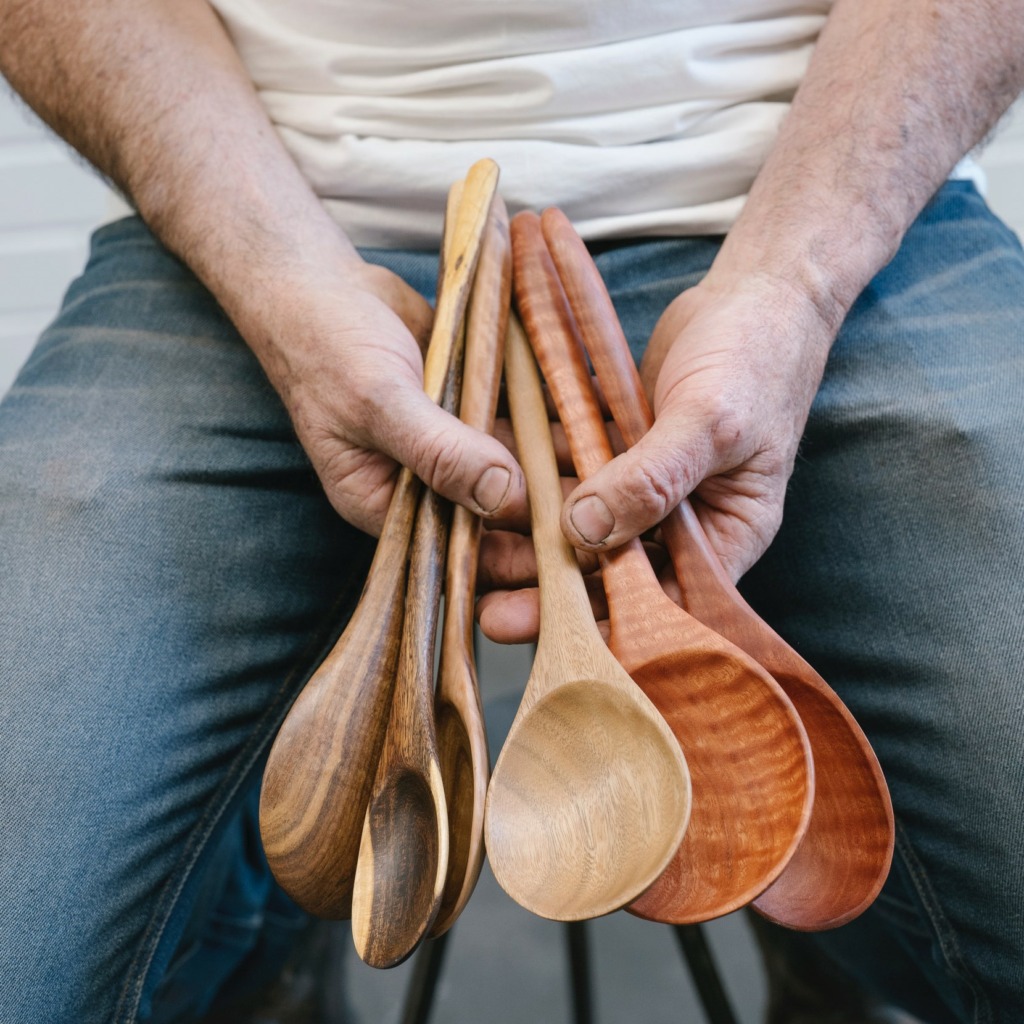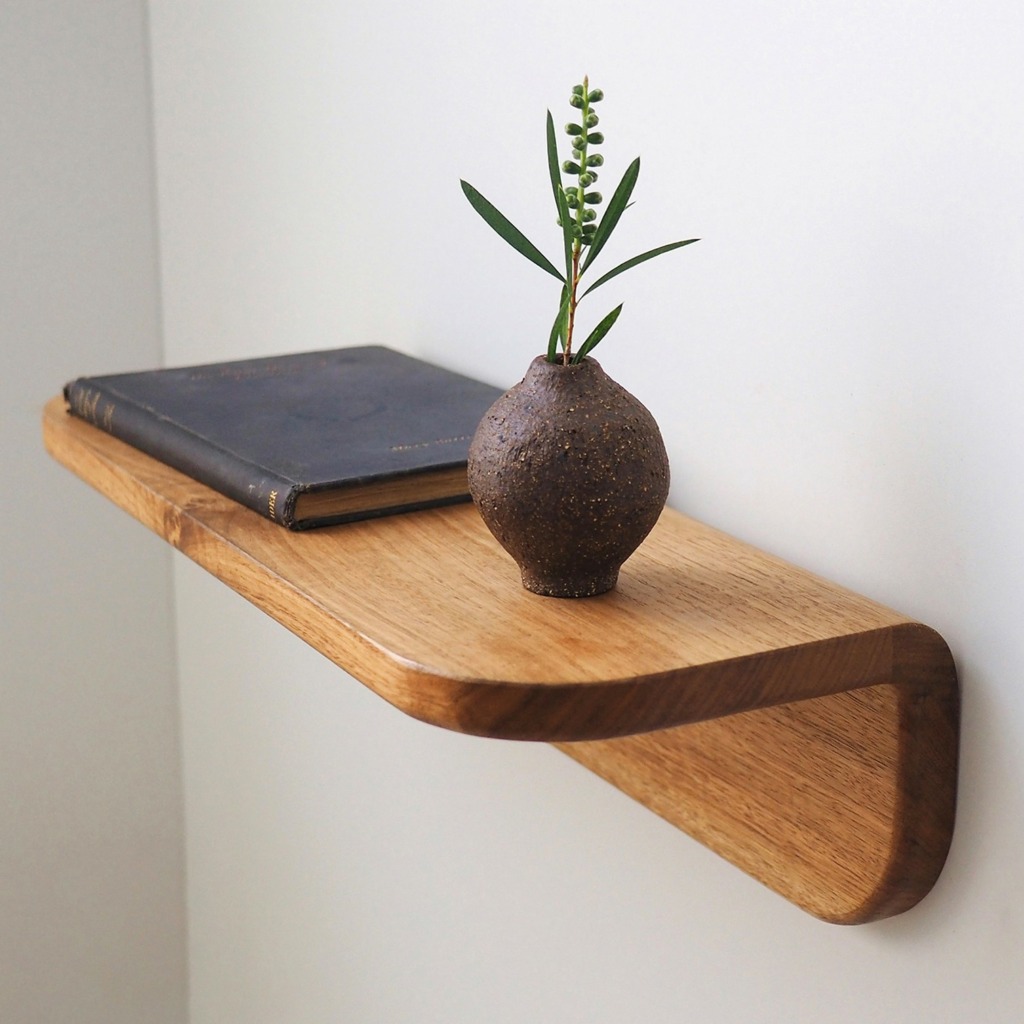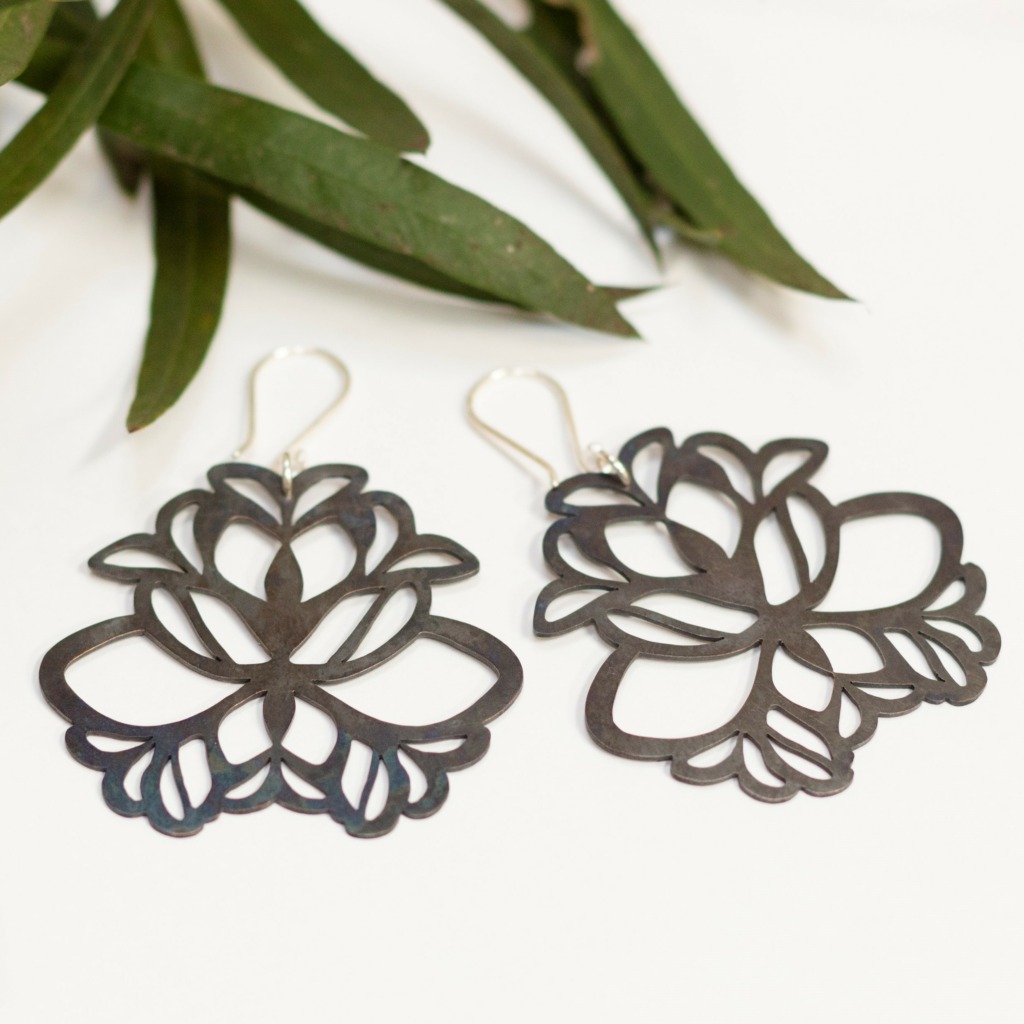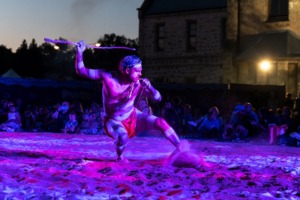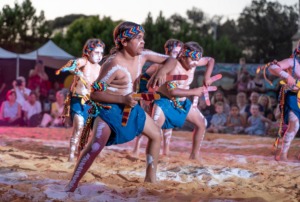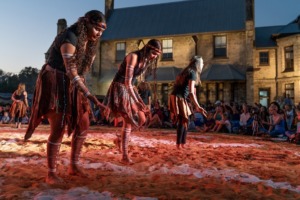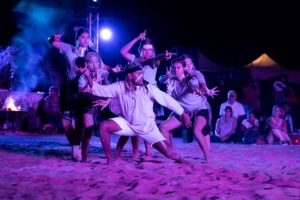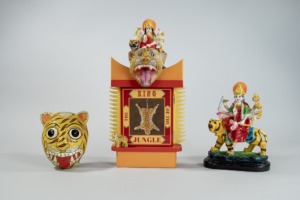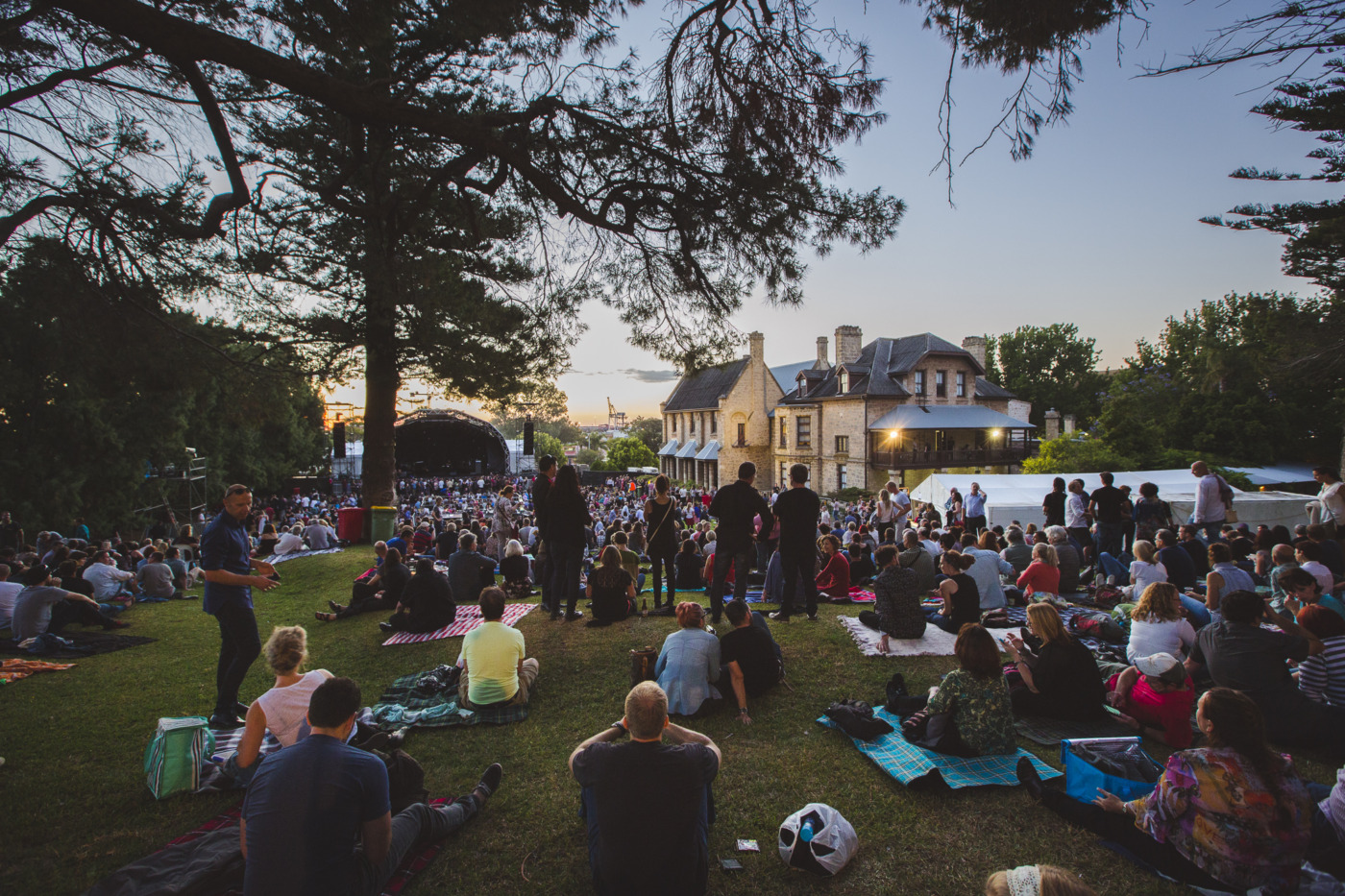Fremantle Arts Centre’s Sunday Music will feature one of its most diverse and youthful lineups to date across January, February and March, rounding out another magnificent summer of free live music in the Port City.
Running 2-4pm every Sunday until 3 April, Sunday Music features a carefully curated selection of some of the most exciting new talent making waves in the local scene, performing on the hallowed yet laidback stage in FAC’s Front Garden.
“Sunday Music celebrates the amazing array of music being produced, performed and streamed to the world, from right here in Western Australia,” said Fremantle Arts Centre Director Anna Reece.
“Sunday Music is about discovery. We aim to present a program that offers something for everyone. We are proud to present new or emerging acts at their peak sharing their music and stories with a largely new audience, many of whom will go on to be loyal supporters for years to come.”
“Not to mention, it’s the nicest gig in town – it’s relaxed, family friendly and free.”
January-March highlights include a celebration of art-rock on 30 January, when emerging local bands Vacuum Dreamer and Didion’s Bible will flex their energetic post-punk, synth-driven sonic muscles.
Then on Sunday 6 February, Banjo Lucia – daughter of WA music royalty John Butler and Mama Kin – makes her FAC debut alongside Ella Therese. Already a passionate and esteemed songwriter, Banjo Lucia’s songs reveal a wisdom, sophisticated turn of phrase and insight into the human condition that is simultaneously heartbreaking and uplifting. Her appearance at Sunday Music kicks off a busy national touring schedule in what’s tipped to be a breakthrough year for the teenager.
On 13 February award-winning singer-songwriter Emily Barker returns to the Sunday Music stage, having recently moved back to her native WA and armed with a fresh new sound full of expressive vocals and a warm acoustic aesthetic.
Then on Sunday 6 March, Sunday Music gets deadly with Northern Territory bands Salt Lake Band and Garrangali Band. Salt Lake Band is a very cool 10-piece coming from the traditional lands of Groote Elyandt, far north in the Gulf of Carpentaria. Singing in their unique and complex language Anindilyakwa, this band of brothers mostly hail from the small communities of Umbakumba and Angurugu. With big drumbeats, strumming guitar and mesmeric, rapid fire language pronouncements by lead singer Yantarrgna, Salt Lake Band acknowledge sacred homelands, elders passed, stories from yesterday and sacred totems tied to each of their 14 clan groups.
Garrangali Band have been wowing crowds for over 10 years with their infectious grooves and proud, meaningful lyrics about deep creation stories and political issues. Adored for their particular brand of upbeat offbeat riddim, Garrangali Band combine traditional songlines with new saltwater ska and reggae, revealing the strength and passion of living culture in north-east Arnhem Land.
Rounding out March are local rnb/soul five-piece Ken Paolo and the Space Cadets (13 Mar), a homecoming performance for Maatakitj (Clint Bracknell) (20 Mar) featuring specials guests Roma Yibiyung Winmar, Iain Grandage, Nigel Bird and more, and an energetic afternoon with Bossa, Calypso and Sri Lankan Baila-inspired group Eucalipto (27 Mar).
Ending the season with a West Coast favourite, much-loved folk singer-songwriter Michael Dunstan wraps up the 2021-22 Sunday Music program serenely on Sunday 3 April.
JAN-MAR LINEUP
- 9 Jan: Grievous Bodily Calm
- 16 Jan: Anesu
- 23 Jan: Mathas + Project Bexx
- 30 Jan: Vacuum Dreamer + Didion’s Bible
- 6 Feb: Ella Therese + Banjo Lucia
- 13 Feb: Emily Barker
- 20 Feb: Erasers + Tanaya Harper
- 27 Feb NO SHOW – Perth Festival Writers Weekend
- 6 Mar: Salt Lake Band + Garrangali Band (NT)
- 13 Mar: Ken Paolo and the Space Cadets
- 20 Mar: Maatakitj
- 27 Mar: Eucalipto
- 3 Apr: Michael Dunstan
COVID Information
Please note that proof of double vaccination is currently required to attend Sunday Music.
Future COVID restrictions may apply.
Media Enquiries
Please contact Rosamund Brennan
rosamundb@fremantle.wa.gov.au / 08 9432 9565
Sunday Music is possible thanks to the ongoing support of Bendigo Bank – Fremantle Community Bank Branch. 2021-22 is the twelfth year of this long-standing partnership.
With Bazaar 2021 just around the corner, we’ve compiled this handy guide of need-to-know tips and tricks to ensure your day at the market is a successful one. Read on and get excited about WA’s favourite Christmas Makers’ Market, which returns to FAC from 3-5 December.
Download the Safe WA app before you leave home
All visitors to Fremantle Arts Centre must register their contact details.
Download the SafeWA app before you leave home for the quickest entry. Then you’ll simply need to scan FAC’s QR code, available at the entrance, before you enter our grounds.
If you prefer not to use the app, speak to our gate staff to register your information.
Your contact details will be encrypted and stored for 28 days by the WA Health Department. They will only be used if COVID-19 contact tracing is required.
Download the SafeWA app in the Apple App Store or Google Play.
Card payments A-Okay!
For the first time in Bazaar Each stallholder, our front gate and all food vendors are fully equipped with card facilities.
Entry is $2 per adult, kids under 12 are free (payable by card or cash).
Cash or EFTPOS payments for products can be processed at reception. Fremantle Arts Centre gift vouchers can also be used at reception.
Parking
Please respect our neighbours and don’t park on the residential streets surrounding FAC. Limited free street parking is available on Finnerty, Ord and Vale Streets. Parking is also available at John Curtin College of the Arts and Fremantle Leisure Centre for a small fee.
Alternatively, take public transport. FAC is a short 10-minute walk from Fremantle train station with several bus routes stopping nearby. Head to the Transperth Journey Planner to find your best route.
BYO shopping bag
While some stallholders have bags available upon purchase, it’s a good idea to bring along your own shopping bag to ensure you get all your goodies home safe and sound.
Grab a Map
Pick up a map at the gate to help you easily find specific stallholders, toilets, bar, food vendors and change rooms.
Gift Wrapping Available
Want your gifts beautifully wrapped? We can help! Gift wrapping is available by donation – head to our station in the Inner Courtyard.
Search #FACBazaar on Instagram
Search the #FACBazaar hashtag for a sneak peek at all the amazing products you can expect to find at Bazaar and to follow stallholders you love.
We’d also love you to share your Bazaar experience with us. If you take any pics over the weekend be sure to tag us @fremantleartscentre and #FACBazaar.
Meet the makers
There’s nothing better than buying direct from makers and artisans. Take the time to chat with the people who have made the things you’re coveting. They’d love to tell you more about their range and how their products are made.
Food & Drink Offerings
There will be lots of yummy food to choose from to keep your energy up while you shop. Head to the food court area at the rear of the building to find a selection of delicious meals from an array of food vendors and a fully stocked bar (open from 5pm on Friday and 12pm Sat + Sun).
This year’s food vendors include: Tommy Taco, FareGo Food Truck, Pak Catering, Banh Mi (Traditional Vietnamese Food), Canvas Café, and Canvas Stall serving coffee and muffins, Big Loaf and La Paleta.
We will also have a water station, so bring your refillable water bottle.
Workshops & Activities
There will be a kids’ activities area located on the top tier lawn, offering Christmas bauble decoration workshops as well as advent calendar colouring in sheets designed by local artists Anthea Carboni and Flora Waycott in the Kids’ Activities Area up on the Top Tier. These run from 10am – 4pm on Saturday and Sunday.
Adults can get in on the making too, learning to create their very own block printed tea towel with multi-disciplinary artist and popular FAC tutor Bori Benko. She’ll guide you through the process of designing, carving and printing onto fabric in this ninety-minute workshop. There are eight sessions available across Saturday and Sunday. More info and bookings available via www.wfac.org.au/courses/adults/
Entertainment
Browsing the stalls will be made even more fun with the addition of live music throughout the weekend, including a roving Mariachi band and brass band, as well as a fun Christmas playlist curated by DJ Rok Riley.
Be sure to pop in and check out Hundreds & Thousands: An Immersive Kids’ Colour Adventure – a vibrant exhibition taking kids and families on a journey through colour and art.
Change Rooms
Change rooms are located on the croquet lawn next to the water fountain near stall 37.
Leave your dog at home
We love dogs but they’re not permitted within FAC grounds.
Treat yourself!
Go on, you deserve it.
Joining us as a stallholder at Bazaar 2021, Ronel Koen is a ceramic artist and the creative brains behind the Swalō Ceramics brand located in the heart of Fremantle. Her practice is inspired by Nerikomi, a decorative process established in Japan that involves stacking colored clay and then slicing through the cross section to reveal a pattern, which can then be used as an applied decoration. Creating a range of unique and one-off ceramic pieces, including ring flower bud vases, bowls and vessels, Ronel is part of our inaugural Bazaar Incubator, a mentorship program for emerging makers in the first five years of their practice or who have never been a part of Bazaar.
Could you please tell me about your ceramic practice and the techniques you are most drawn to?
Most of my work is inspired by and explores the principles of Japanese Nerikomi techniques. In Nerikomi, slabs of clay are layered, folded, and pressed, over and over until it creates a beautiful design or pattern. I am exploring creating very precise designs and patterns through the controlled layering and placing of colour-stained clay and then inlaying these designs into wheel thrown vessels. This inlaying process creates pressures, distortion and introduce movement into the pattern making every piece I create completely unique and visually dynamic.
Other than my exploration of Nerikomi, my practice is a study of the intricate relationships between aesthetics, form and function and my work aims to bridge the divide between function and art. Each piece is carefully conceptualised and created around a core narrative where each form follows this narrative. My work aims to return art, and the art experience, to everyday living.

Hummingbird Water Can & Vase
How long have you been making ceramic work and what is it about this particular art form that you love?
My intense and lingering love affair with clay started over 27 years ago as a young fine and applied arts student in South Africa. But as life often does, mine turned and wound into other directions, and for the past 20 years I’ve been building a creative career as a designer and art director, both in Australia and abroad. It’s a journey that’s been fabulously rewarding, but as with all great loves, that yearning for clay stayed with me and kept drawing me back.
I missed the physical rawness of the artistic process, the hands-on making, and the fact that clay forced me to slow down. How it just so shamelessly and unapologetically commands my attention. Ceramics feels relatable. It’s a tactile, primitive medium, where you can create strikingly beautiful work, that actually has a practical purpose. I see working with ceramics as an opportunity to push the boundaries of how we perceive art, and create pieces that cross the divide between art, and object.
What kind of products can people expect to see at your stall at Bazaar?
I will be presenting a beautifully curated range of functional and decorative handcrafted ceramics. From high end, one-off Nerikomi designs, a range of unique ring flower bud vases, bowls and vessels, watering cans, incense burner to quirky little stocking fillers. There will be something unique for everyone and every price range.
You are part of our inaugural Bazaar Incubator, a program which mentors makers within the first five years of their practice. What has that experience been like?
It has been an incredible opportunity to be included in such a well-respected, iconic and coveted event that most small business like mine would otherwise not have access to. It will be a very important springboard for my young fledgling business which will help to introducing and connect products with my local community and market and increase awareness of my brand. The FAC has been amazing in offering support and reassurance and making me feel confident in gearing up my production and work for the Bazaar. I am so grateful for this wonderful opportunity.

Nerikomi Vase
Why do you think people should support local makers and buy handmade Christmas gifts?
First of all, handmade products are great for the environment. Most handmade products do not require large production facilities. Instead, are made locally in small studios or small workshops.
Handmade is always unique, made by a real artist or person, which makes the product and the purchase very special. It gives you access to the maker and artist and nobody in the world will ever have exactly the same item as the one you have purchased. Each handmade item has a unique story behind it and by buying it you become part of the story.
When you buy handmade you directly support a local artist, which in return help in supporting traditional crafts and practices. By supporting these practices, you help pass them on to the next generation keeping the arts and crafts alive. But mostly, buying local shows the person that you are giving to that you care.
Bazaar – WA’s premier Christmas makers’ market – runs from 3-5 Dec at Fremantle Arts Centre.
From 3–5 December, Fremantle Arts Centre’s Bazaar – WA’s favourite Christmas makers’ market – returns to the port city.
This much anticipated annual market brings together more than 50 local designers, artists and craftspeople – offering unique, handmade gifts and homewares including jewellery, textiles, ceramics, woodwork, fashion, prints, stationery, toys and more.
Fremantle Arts Centre Director Anna Reece commented, “Bazaar is a celebration of the handmade, offering our community a rare chance to browse the highest quality gifts from WA artisans all in one place – alongside music, craft workshops, delicious food and plenty of Christmas cheer.”
“It’s an event that embodies Fremantle Arts Centre’s role as a home for makers, a place that fosters creativity and forges connections between artists and the community. Treat yourself or a loved one to an exquisite creation while supporting our local creative industries.”

Among the diverse creations on offer at this year’s event, you’ll find recycled timber furniture by wood craftsman Tony Docherty, who has exhibited his works at Tokyo Design Week and Milan’s Salone Satellite, and Deep Earth Ceramics’ collection of vases, keep cups and bowls, lovingly handcrafted in Fremantle.
Also joining the stallholders is self-confessed knitting addict Gloria Toniatti of UFFA Collective, who will present her one of a kind knitted creations and textiles, and Dunsborough based contemporary jeweller Nicola Macklin of NTM Jewellery, showcasing her ‘perfectly imperfect’ silver earrings, rings, necklaces and bangles.
New to this year’s event is the Bazaar Incubator, a mentorship program which provides support and guidance to 5 emerging artists who have never before traded at Bazaar, including homewares designer Kamisaki Studio, textile artist Mamy Hews, Swalo Ceramics, Manner Furniture and Pottery By Shupiwe.
- Tony Docherty
- Ceramics by Danica & Beste
- Turner & Turner
- Jewellery By Susannah & Ilka
Another new addition to this year’s event is a series of craft workshops for kids and adults running throughout the weekend. Kids can enjoy Christmas decoration workshops as well as advent calendar colouring in sheets designed by local artists Anthea Carboni and Flora Waycott. For adults, multi-disciplinary artist Bori Benko will lead a block printing workshop where you can decorate your own linen tea towel.
To keep visitors in the Christmas spirit there’s also a bar and delicious food options all weekend, in the lush surrounds of FAC’s grounds, as well as the occasional surprise pop up performance.
2021 Bazaar Stallholders
Andrea Osses Design
Bedtonic
Belen Berganza
BLACK & DAWSON
Blue Lawn Designs
Braw Paper Co.
Ceramics by Danica & Beste
Claymake Collective
convict
Daniel(ink.)
Deep Earth Ceramics
Dingo Sauce Co
Fleur Schell
FOUND
Golden Whisk
i j e w e l l e r y
Jessica Jubb Jewellery
Jewellers & Metalsmiths Group of WA Inc
Juluwarlu Art Group
Kamisaki Studio
KIN SWIM
Kor by Lisa Gardner
Kristin Magrit
Mamy Hews
Manner
Many Peaks Assembly + Deli Mates
Map Journal
Melting Pot Glass Studio
Nagtzaam
Nagula Jarndu (Saltwater Woman)
Native Needle
Nikked glass
NTM Jewellery
Patong /Alison Bullock
Penelope Brittain Jewellery
PIXEL CAT
Pottery by Shupiwe
Prints By Bow
Robin Wells Jewellery + Eucalypt Homewares
Semblance
SWALŌ Ceramics
Tinctorium
Tony Docherty
Turner + Turner
Two stories
UFFA Collective
Viviana Maier Porcelain Objects
Woven Stories Textiles
You Me Berlin & Susannah Kings-Lynne
Yuniko Studio
Bazaar runs Fri 3 – Sun 5 Dec (5–9pm Fri, 9am–5pm Sat + Sun). $2 entry, free for kids under 12. Bar + food available.
Media Contact: Rosamund Brennan, rosamundb@fremantle.wa.gov.au, 08 9432 9565
Senior visual artists and husband and wife duo Richard and Yoshiko Gunning are current Artists in Residence at the Fremantle Arts Centre. Housed in Studio 6, an airy, light-filled space bigger than most studio apartments, Richard and Yoshiko have been steadily working towards a new exhibition, Luminous Pursuit, which opens at Nyisztor Studio on 30 October.
Combining Richard’s skill in painting interior and domestic scenes with Yoshiko’s delicate installations combining floristry and sculpture, the exhibition provides a voyeuristic glimpse into the couple’s life at home.
It’s partly inspired by the magnificent light flooding through their home after they knocked down some interior walls – replacing them with screens that reflected soft, multi-coloured rays across their living room, and drawing on Yoshiko’s Japanese heritage.
Ahead of the opening, we chatted to them about the process of creating work together, their residency at FAC and the development of Luminous Pursuit.
Yoshiko, you are known for creating pastel self portraits and interior works, but more recently you are integrating your training as a florist within your practice. How are you approaching this for Luminous Pursuit?
I recently studied floristry and I work in that industry. My aim is to combine my visual art and floristry together – it seems like a natural progression for me. I’m working with resin and some other materials to create some sculptural forms with preserved plant materials in them to create works which play with composition, light and space.
Richard, one of the more striking pieces of the exhibition is a 1.8 x 2.4 metre room divider or screen featuring a domestic scene you painted. What exactly are we looking at here?
Yes that’s right, the painting on the screen is based on the interior of where we live. It’s a domestic scene painted across the panels of the screen and in it you can see our apartment, with Yoshiko doing her hair in the bedroom and our son making a meal in the kitchen. You can see that I’ve painted a piece of clothing in the top left corner – playing with perception and illusion, also drawing on the fact that room dividers often are used in this manner, for people to get dressed.

Richard Gunning in his studio at Fremantle Arts Centre
What gave the idea to start working with screens?
It’s partly drawn from a work I created about 25 years ago on a screen. I felt that this medium would marry well with the works Yoshiko is creating for the exhibition. A screen is somehow a little less intrusive than a painting. The space at Nyistor gallery is generous as well, so it lends itself to a larger work.
Richard, what attracts you to painting these domestic scenes which explore light and space?
I’m drawn to interiors simply because they are the space that we occupy. I anticipate doing landscapes as well and I have done landscapes, but part of the appeal of interiors is that you can control them a little easier. The same is the case with still life. So it’s kind of a progression on that. I work from life, as opposed to photographs. I never find photographs particularly appealing to work from as they are too static and don’t capture the full breadth of light and colour.
I understand this is the first time you have presented an exhibition together? What was it like working together?
Yoshiko: Yes, this is the first time. We’ve always created works separately and, even if we are working in the same space together, we try not to influence each other too much. But we thought it was about time we made something together, especially seeing we have this big space to work in together.
How does having a studio at Fremantle Arts Centre benefit your art practice?
Richard: One of the best things about having a studio here is that it’s not an outcome-based program, so you really have the freedom to experiment and develop your practice however you choose.
And the exhibitions program is fantastic, from the more contemporary exhibitions to the historical works in the Collection, it’s wonderful to have exposure to that while you are working, and that’s not always the case with studios.
Luminous Pursuit is at Nyisztor Studio from 30 October – 14 November
From 20 November, Fremantle Arts Centre presents Hundreds & Thousands: an immersive kids’ colour adventure, bringing the magic of colour to life with dazzling interactive artworks, highly sensory installations and educational experiences that invite curiosity, discovery and play.
Meandering through a spectrum of colour-themed spaces, audiences will encounter soft sculptures to touch, kaleidoscopic wall installations and twinkling fields of colourful lights—designed to spark little imaginations while expanding boundaries of perception and understanding.
Hundreds & Thousands brings together more than 20 artists of national and international renown including Sydney Ball, Brian McKay, Laurel Nannup, Ngamuru Bidu, Giles Hohnen, Tarryn Gill, Jeremy Kirwan-Ward, Rohin Kickett, Penny Coss, and Darren Siwes.
Among the exhibition are nine newly commissioned works by artists including Phil Gamblen, Rosie Deacon, Angela Ferolla, Sohan Ariel Hayes and Rachel Riggs, including surprising participatory works and unique colour stories that engage the senses in unexpected ways.
Bringing together works of magnificent scale and imagination, Hundreds & Thousands invites children to marvel at the joys of colour, to explore the intimate relationship between colour and emotion, and to reflect on the colourful moments in their own daily lives.

Kate Rohde, Ornament Crimes, 2015, mixed media, dimensions variable, exhibited at the National Gallery of Victoria
According to Glenn Iseger-Pilkington, Hundreds & Thousands co-curator, “The exhibition is a celebration of colour, an important aspect of visual language that many of us experience just months after entering the world. Hundreds & Thousands unites works from the City of Fremantle Collection and loans from private collections with recent commissions from leading Western Australian artists.”
Emma Buswell, who worked alongside Glenn as co-curator, commented, “Going to the Arts Centre as a kid was always a treasured time, walking through giant hallways, large than life galleries and grounds filled with flowers, birdsong and dappled light. It is exciting, decades on, to reimagine these spaces for a younger generation.”
Among the exhibition’s highlights, Perth-based artist Phil Gamblen will build an immersive installation of 3D-printed forms, each containing a programmed LED bulb. Upon first glance the forms appear white, but when the audience moves across them, they refract brilliant rays of colour that welcome movement and play.
Known for her intensely colourful sculptural objects, Melbourne-based artist Kate Rhode will create a large-scale kaleidoscopic wallpaper installation. Featuring dazzling neon patterns, this installation becomes an immersive point of entry to FAC’s galleries. The Ramsay Prize finalist will also exhibit a vivid series of whimsical cast-resin objects that speak to both real and imagined worlds.
Renowned puppet-maker Rachel Riggs will create a highly interactive work which encourages visitors to create stories using light and shadow, a tradition dating back in time. Meanwhile, Sydney-based artist Rox de Luca will present her extraordinary sculptural garlands of found-objects. The works, which feature hundreds of shards of plastic and debris collected from beaches in Bondi and Rose Bay, are a defiant commentary on the deluge of plastic waste that our species generates daily.
Local artists Catherine Taylor and Tyrown Waigana are working together to create a multitude of soft sculptures which audiences can touch and interact with. Created using recycled yellow fabric, these small minion-like creatures are an adaptation of one of Tyrown’s animations, made with the help of Catherine’s vast experience in costume design and textiles.
Taking place on 20 November, the Hundreds & Thousands exhibition opening will be a day-time affair for kids and families to enjoy, including family friendly entertainment, food, games and an array of interactive activities.
Following the opening event on Sunday 21 November, a specially curated edition of Sunday Music will brighten up the Front Garden, with Odette Mercy and her Soul Atomics’ Kids Soul Party offering up colourful tunes, dancing and kid-friendly fun.
A series of colourful public programs and special events will accompany Hundreds & Thousands, including pin-wheel flower making, community kite-flying days, special artist talks and education programs about the science and theory of colour.
Fremantle Arts Centre is also introducing a quiet hour to view the exhibition from 9-10am, available upon request. Groups and families wanting to experience Hundreds & Thousands in a more relaxed, unhurried environment can request access to the galleries for an hour before they open to the public. Enquiries can be emailed to artscentre@fremantle.wa.gov.au.
Hundreds & Thousands runs from Sat 20 Nov till Sun 23 Jan, 10am – 5pm daily. Free entry. For more information, please visit fac.org.au
Media Contact: Rosamund Brennan, 08 9432 9565, rosamundb@fremantle.wa.gov.au
Melbourne-based artist Shaun Wilson is Fremantle Arts Centre’s first ever Online Artist-In-Residence. The program was created as a response to creating art during the time of border restrictions and social distancing — providing virtual space for artists to explore and create digital art, to build online communities, and to have dedicated time and space for experimenting on something new.
An artist, film maker, academic and curator working with themes of memory, place and scale through painting, miniatures and video art, Shaun is using the online residency to develop a project called Revisiting the Decameron, part of a wider investigation ‘Winter Light’ examining the beauty and horror of plague through contemporary art.
‘Revisiting the Decameron’ deconstructs ‘The Decameron’, a series of novellas written by medieval author Giovanni Boccaccio around 1348. These stores digress seven young people sheltering in quarantine at an abandoned villa outside of Florence during the Black Death pandemic. The new works will situate the ten days of stories into a suite of ten works contextualising the backdrops of the Black Death and COVID-19.
Your online residency deconstructs ‘The Decameron’, a series of novellas written by medieval author Giovanni Boccaccio around 1348. How did you come across the Decameron text?
I’ve investigated the notion of place in my practice for almost two decades. In the midst of the COVID-19 pandemic, I felt compelled to explore how our connection to place had been ruptured, so I made a whole list of seminal books I wanted to get through which referenced plagues throughout history such as The Journal of the Plague Year by Daniel Defoe and Dante’s writings, and that research led me to a series of books that I’d never heard of before, including The Decameron.
What was it about The Decameron that resonated with you?
Well, the book is about ten wealthy young adults who flee Florence for the countryside during the Black Death. They hide in a villa outside of the city for two weeks and quarantine there, doing what normal young people would do in the middle of a disaster: entertaining themselves. There are stories of sex, romance and power. Reading this, you realise that perhaps we as humans perhaps haven’t changed all that much.

Online Artist-In-Residence Shaun Wilson working on his series Revisiting the Decameron
What I find really interesting about the text is that it is not unlike what is happening today. In Florence at the time of The Decameron, they shut the gates of the city and only the wealthy were allowed out, while the lower-class citizens bore the brunt of the disease entrapped in the walls of the city. I’m reminded of the social inequalities today of essential service workers where the low paid casualised workforce ploughed on through the pandemic while the lucky ones worked from home – like me – serviced by those who stayed in the front lines. Where is the social celebration of these people who supported the likes of me having the luxury of working from home? The Decameron makes this point loud and clear inasmuch as it does about the separation of places from which I normally would travel and move through.
The Black Death killed one in two people globally, but most of those people were those who were stranded in these gated communities. From this and others, there is a real class structure that has gone on throughout pandemics, and you see it even today in Victoria – with huge outbreaks happening in the city’s western and northern suburbs and these are often the places of industries which support the rest of us. It really makes me mad from a utilitarian point of view. The general populace is used as sponges to soak up pestilence and I wish there would be more attention on celebrating those in the front lines, from ICU wards to supermarket workers. They’re the unsung heroes who are always in the back of my mind when I paint these pictures of places from the book simply because the absence of those stranded in Black Death era Florence are also absent from the landscapes that I’m trying to capture as the silent characters in both the book and my paintings.
Why were you drawn to the online space as a place to explore these ideas as opposed to presenting a regular exhibition or a traditional residency?
I think doing an online residency during lockdown is really important because it’s the only way we can stay connected while isolated from one another. Also, I think it allows me to get in the right headspace to connect with the subject matter. We’ve all been living the last 18 months like the characters in the Decameron in some way or another.
I don’t think I could understand what that book meant until I knew what the characters were going through. It’s the best way to do it – conceptually and philosophically. It adds an honesty and an authenticity to making these paintings which on the surface may look like landscape paintings but conceptually, they’re loaded with the fact that I want to travel to places like those in the paintings but I can’t at the moment. So, it’s obvious that I’d make landscape the focus in lockdown, as we’re all dreaming of those landscapes that we can’t yet travel to. Place then becomes the central experience of lockdown secondary to health.
What have been some of the key challenges of the online residency?
I come from 20 years of cinematic art and video practice, but I didn’t want to resort to my usual bag of tricks in terms of how I was going to respond to this book, I just thought that’s too easy, I need something that’s hard. I’ve already had to teach myself and relearn everything I once employed about painting that I’d almost forgotten. It’s all flooded back rather quickly.
I haven’t explored 2D like I have this year, I’ve just gone bananas. The house looks like an art gallery! There’s been a lot of drafts and works in progress that haven’t even made it online. For every work you see I find it takes about three false starts before I get my visual language back together and into a rhythm again. The residency has mostly been about failure but at the same time, victory in small accidents.
What are you hoping the audience will take away from Revisiting the Decameron?
I guess there are two things, one of them being that I would like more artists to engage with innovative ways of making work and engaging with an audience during a lockdown. The pandemic has forced us to adapt our ways of working, and the visual arts is no exception. The online space offers so much flexibility and visibility which I hope more artists will take advantage of.
And secondly, I’d like the work to prompt people to think about how the pandemic is impacting not only themselves but at all levels of society through place. Who is being exploited or marginalised? Who is gaining an unfair advantage in this pandemic? What has changed between now and the Black Death? Every major pandemic has prompted a socialist revolution in some capacity about five or 10 years after the fact – we see this with the peasant revolt after the Black Death which then evolved through enlightenment to the early Modern period paving the way for the Renaissance; we see this in the 1665 plague of London with the burning of London and the reordering of enlightenment thinking through town planning in the restoration of London, we saw it in the rapid social transformations in the 1920s after the Spanish Flu propagating strengths of feminism and medical advances, and so forth. And we’ll see it happen after COVID-19 is over.
It’s an opportunity for us to reflect on the roles we play, individually and collectively to make our society, and from this, ourselves more intrinsic to the new world which we have the opportunity, warts and all, to rewrite. Again. But what I find is the most valuable and also the most painful of all is our relation to landscape and to our sense of place. Perhaps our experiences of the pandemic will allow us to reconsider place so invaluable that our lives need each other inasmuch as we need the connections to the places we dwell in, through our communities, through our lives, and of course, through the power and immediacy of art.
View Shaun Wilson: Revisiting the Decameron via studio.fac.org.au
Immerse yourself in one of the world’s oldest and richest cultures at Wardarnji 2021, a spectacular evening of Nyoongar dance, performance and storytelling returning to Fremantle Arts Centre on Saturday 13 November.
After being postponed in 2020 due to COVID, this much-anticipated event will bring together more than 100 dancers performing traditional songs and dances alongside contemporary original works, magnificent puppetry, fires burning well into the night and an array of markets showcasing the talents of local Aboriginal makers.
Directed by WA Aboriginal Person of the Year Karla Hart, Wardarnji offers a rare opportunity to experience the diversity of dance, song, language and story from 14 different clan groups across the Nyoongar nation – celebrating this ancient and venerable culture.
According to Karla Hart,
“On Nyoongar country we are so empowered by dance and have many pioneers that have blazed a trail for decades – supporting and encouraging us as we go along on our cultural journeys, strengthening and reclaiming what is our birthright and bloodline.”
“Wardarnji is a direct representation of all of that. It is not only for our Indigenous community but for our non-Indigenous family that love to come share with us, who have the same sense of pride and love for culture and dance. It is a beautiful way of coming together, to feel as one, as this is a culture that belongs to the country that we all live on.”
Wardarn is the Nyoongar word for sea and in 2021 will inspire much of what the audience will see and experience including the exquisite puppetry and more organic and immersive staging referencing our coastal sand dunes.
Merging contemporary dance with live puppetry, a highlight of Wardarnji will be the sharing of the Nyoongar story of Waarlitj the Eagle, Chiriger the Grey Wren and how the blue wren got its colours. The puppets will be made with the help of the community via a series of workshops held at Fremantle Arts Centre facilitated by puppeteer Rachel Riggs and Nyoongar artist Nerolie Bynder.
Other highlights include a dynamic contemporary dance piece presented in collaboration with ZAP Circus, the award-winning Western Australian performance company known for blending acrobatics, fire, pyrotechnics and comedy.
Collaborating with Karla Hart on Wardarnji this year is celebrated Nyoongar artist Mark Howett. A multi-Greenroom and Helpmann Award winner, Mark has worked as a lighting, video, set designer, artistic director and production manager, on over five hundred national and international productions.
Joining us as Master of Ceremonies for the evening are Nyoongar community leaders Olman Walley and Thierra Clanton. The director of Boorloo Aboriginal Cultural Experiences, Olman is an acclaimed performer and storyteller. Thierra is an environmental scientist and seasoned MC who is passionate about sharing Nyoongar stories, history and knowledge.
Fremantle Arts Centre Director Anna Reece commented,
“Aboriginal culture is a living, breathing, and edifying force in Walyalup (Fremantle). The Whadjuk people have long danced, sang and passed on their culture here, observing and following the seasons and listening to and respecting country.”
“Wardarnji is a generous sharing of that culture, a nationally significant celebration of the world’s oldest culture and language, and we are honoured to once again produce and present it here at Fremantle Arts Centre.”
We invite you to bring a picnic, browse the market and food stalls showcasing the talents of local Nyoongar makers, artists and small businesses, and immerse yourself in an evening of strong proud Nyoongar culture performed by more than 14 dance groups.
Event Information
This is a free family friendly event, suitable for all ages. We recommend arriving early to secure a spot.
- BYO picnic blankets
- Food and beverages available to purchase, no BYO alcohol
- Very limited seating provided
- Gates open at 5pm
- Performance begins at 6:30pm
Media contact
Rosamund Brennan, rosamundb@fremantle.wa.gov.au, 08 9432 9565
Images: Wardarnji 2019. Photography by Pixel Poetry
Sharyn Egan is a painter, weaver and sculptor. As a member of the Stolen Generation who grew up in the New Norcia Mission School much of her artwork is a commentary on her life as a Noongar woman and the associated trauma, emotions and deep sense of loss and displacement experienced by Aboriginal people.
Never afraid of experimentation and exploration, she works in numerous media, including painting, sculpture, woven forms and site-specific installations, often choosing materials, such as ochres, resins and grasses that connect to land, especially her home near the lake system in the southern suburbs of Perth.
At the Indian Ocean Craft Triennial’s inaugural exhibition Curiosity & Rituals of the Everyday, Sharyn will present her collaborative installation What’s in a Noongar woman’s bag? Naatj Noongar yoka kooda, an exploration into the daily lives of her ancestors, using historical research and oral histories to trace the belongings found in a Noongar women’s bag in the 1800s.
How did you come up with the concept for What’s in a Noongar Woman’s Bag (Naatj Noongar yoka kooda)?
I was approached by Maggie and Jude to develop a project for IOTA 2021. I think it’s really important for Aboriginal women to have an understanding of where they came from and what life was like for their ancestors. I’m from the stolen generation, my mum is from the stolen generation and so is my grandmother.
So, this project aims to bring back a bit of knowledge about the generations before, and how life wasn’t that easy for them. They had to be prepared, organised and responsible, as they weren’t just looking out for themselves, but their whole community. In their bags, you wouldn’t find lipstick and mirrors, but objects that were essential for survival.

Sharyn Egan, What’s in a Noongar Woman’s Bag? Naatj Noongar yoka kooda 2021. Collaboration with Djidi djidi group. Gail Beck, Luana Daley, Margaret Drayton, Brenda Hill, Doris Hill, Kaye Walley, Marie Walley, Kathleen Toomath, Larissa Perry, Georgia Shuttleworth. Kangaroo skin, found objects, dimensions variable. Photography by Christophe Canato.
I understand the project was based on a list written in 1839 by the explorer Sir George Grey. How did you come across this information?
In the year 2000 I did a cultural tourism course at Fremantle TAFE, and that’s where I came across George Grey’s list. It details 23 objects typically found in a woman’s bag, with contents including a flat stone to pound roots, cakes of gum to make and mend weapons, kangaroo sinew to make spears and sew with, banksia cones or dry white fungus to kindle fire. I was really intrigued by it and always wanted to learn more about it, and I guess this project for IOTA offered the perfect opportunity to do that.
When I started to research, I came across another list by a woman named Ethel Hassell, a colonial author who lived near Albany and wrote several texts on the Noongar people of Southwest Australia. She had a pretty comprehensive list, including a few extra items, and it was written very much from the woman’s perspective, so it was a great resource for this project.
I understand you collaborated with a group of 14 Noongar women to develop this project – including taking some trips out bush to collect materials and create the kangaroo skin bags. Were there any interesting discoveries made on your travels?
Yeah most of the women were friends of mine or people I had worked with before, but we were from quite diverse Noongar groups. I invited them to come away on some trips, and there was lots of storytelling and sharing, and discussing what life was like back then.
We went up to Yued Country (New Norcia). I grew up in a mission there and so did one of the other ladies. So we talked a lot about what it would’ve been like before the Europeans settled, the landscape and the stories of our ancestors there. Speaking about our heritage while we were there, walking on the land together, collecting materials like sinew from kangaroo tails and banksia cones to kindle fire, was pretty special.
It just made us appreciate bush medicine and fixing things, and how resourceful our ancestors were. They really made excellent use of what they had in front of them, and it all came from the land. The contemporary tools are not necessarily better.
And what will the bags be made of and how will they be displayed?
They’ll be made of kangaroo skin and sinew from the kangaroo tails. They will be quite contemporary in terms of style, like a modern woman’s shoulder bag with a strap, but made from traditional materials. Each of them will contain some traditional materials a Noongar woman would’ve carried in the 1800s, so the audience can have a peek in, plus we’ll have a table with an open bag with its contents sprawled out for ease of viewing.
Curiosity and Rituals of the Everyday is showing at FAC as part of the Indian Ocean Craft Triennial from 18 Sep — 7 Nov 2021.
The Indian Ocean Craft Triennial (IOTA) is a new festival that celebrates the traditions and rituals of contemporary craft, bringing together makers, artists and crafted works from countries around the Indian Ocean Rim.
Opening on 17 September, IOTA’s inaugural exhibition Curiosity & Rituals of the Everyday, presents the work of more than 30 artists from seven countries across two venues: Fremantle Arts Centre and John Curtin Gallery.
From the exquisitely detailed textiles and embroidery works of Jakkai Siributr (Thailand) to the painted carpentry of Ishan Khosla (India) and his team of artisans, the exhibition presents strikingly modern installations and stories of our time that are firmly planted in craft traditions.
Fremantle Arts Centre Director Anna Reece said, “Both ancient and contemporary, craft is a universal language capable of bringing people together, of creating intimate moments for reflection and speaking to the myriad of experiences that make up daily life across the Indian Ocean Rim.
“We are so proud to host IOTA’s principle exhibition Curiosity & Rituals of the Everyday, which calls out across the oceans with rich and evocative stories of culture, life and times from countries including India, Thailand, Malaysia, Singapore, Kenya, South Africa, and indeed Australia. A celebration of how deeply embedded cultural practice has and will always be in craft making.”
The official opening of IOTA21 on 17 September will see cultures come together, as Fremantle Arts Centre is transformed into a joyous celebration of dance, song and music. With performances by Noongar artists, classical Indian musicians and dancers from Saraswati Mahavidhyalaya, Tamil drummers, contemporary African performances, and much more. There will be delicious food from the unique cultures of countries represented in the triennial including Kenya, Singapore and Thailand.
Among the highlights of Curiosity & Rituals of the Everyday, Sharyn Egan, a Noongar painter, weaver and sculptor from Western Australia will present What’s in a Noongar woman’s bag? Naatj Noongar yoka kooda, a collaborative project developed with a group of Noongar women who are recreating bags made and carried by their ancestors. The starting point for the project was explorer George Grey’s comprehensive list of 23 objects typically found in a woman’s bag, written in 1839.
Ishan Khosla, an Indian designer and artist has worked with a whole community of artisans for his painted carpentry works. Khosla’s works blend contemporary Indian advertising with the traditional kaavad — a portable shrine and storytelling device — to explore concepts concerning contemporary Indian life.
Kenyan artist Cyrus Kabiru will present his spectacular wearable masks, made from scrap metal sourced from Nairobi, and Fremantle-based textile and embroidery artist Susie Vickery will present an immersive installation that will take audiences on a journey through the ocean with five curious women, past and present.
Jude van der Merwe, Co-Curator and Project Leader of IOTA, commented, “Showcasing artists from more than seven countries, the exhibition is a cross-cultural exploration of craft and the handmade across our region, offering a new, contemporary lens on this ancient practice.
“From ceramics to metalwork, embroidered and woven textiles, woodwork and pearl shell carving, the works demonstrate the incredible skill of the artists while shining a light on the importance of craft as a vital livelihood and a vehicle for community resilience.”
Taking place from September through to November, the broader IOTA21 festival program includes exhibitions, a conference, talks, workshops and a fashion event.
Curiosity & Rituals of the Everyday runs from Sat 18 Sep 2021 — Sun 07 Nov. For the full IOTA program visit indianoceancrafttriennial.com
Exhibiting Artists – Fremantle Arts Centre
Sharyn Egan (WA)
Sarah Elson (WA)
Audrey Fernandes-Satar & Arif Satar (WA)
Cyrus Kabiru (Kenya)
Ishan Khosla (India)
Darrell Sibosado and Darrell Jade Kyle (WA)
Garry Sibosado (WA)
Uday Singh (India)
Jakkai Siributr (Thailand)
Wuthigrai Siriphon (Thailand)
Thania Petersen (South Africa)
Susie Vickery (WA)
Liz Williamson (NSW)
Exhibiting Artists – John Curtin Gallery
Melissa Cameron (WA)
Tjanpi Desert Weavers – Judith Yinyika Chambers and Nancy Nyanyana Jackson (WA)
Kaaru – Sanjib Chatterjee and Anjalee Wakankar (India)
Kirit Dave (India)
Sunny Dolat (Kenya)
Andile Dyalvane (South Africa)
Pierre Fouché (South Africa)
Gaurav Jai Gupta (India)
Jan Griffiths (WA)
Yee I-Lann (Malaysia)
Shakuntala Kulkarni (India)
Desmond Lazaro (VIC)
Anniketyni Madian (Malaysia)
Athi-Patra Ruga (South Africa)
Garry Sibosado (WA)
Uday Singh (India)
Madhvi Subrahmanian (India)
Zizipho Poswa (South Africa)
Monique Tippett (WA)
Artwork details (from top)
Cyrus Kabiru Macho Nne, Amboseli Mask, 2017, C-type Print on Diasec Mount, 70 x 60 cm
Ishan Khosla with Anoop Sharma and Tasleem Ahmed, Formerly known as the king of the jungle, 2021, acrylic and digital print on wood, 35.5 x 24.3 x 12cm
Susie Vickery with Bappaditya Biswas, Kolkata, India; Janakpur Women’s Development Center, Janakpur, Nepal; Mark Binns, Fremantle, The Curious Five Go Surfing (detail), 2021, cotton thread, cotton, found objects, 50 x 35cm
Media contact
Rosamund Brennan, rosamundb@fremantle.wa.gov.au, 08 9432 9565


